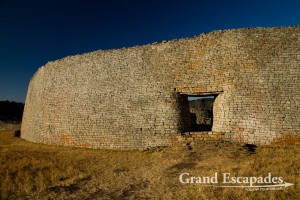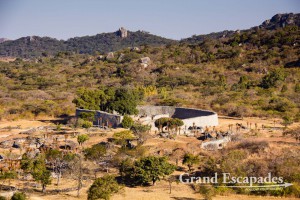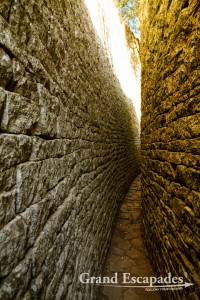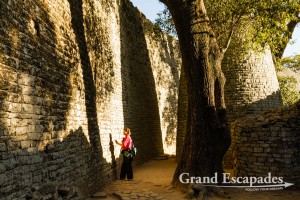Great Zimbabwe is the largest stone structure ever built south of the Sahara. In its heydays (between the 11th and 14th century) it served as the royal residence of an empire that reached from Botswana to the coast. Trading gold and ivory for clothes, beads and ceramics with far away places like India, Arabia and China made the city rich.
The mighty stone walls may easily be mistaken for fortifications, but they were not. Scientist came to believe that the high (11 meters) and thick (6 meters) walls served as a status symbol for a long succession of kings trying to outshine each other by building higher and more elaborate structures. An estimated one million stones were shaped to perfectly fit into each other. No mortar was used.
Now our confession… We had never heard about Great Zimbabwe before travelling here. Not knowing what to expect we were even more excited actually setting foot in this place. We desperately tried to find a guide, without success. So we climbed up to the hilltop complex reading along in our guide book. This maze of enclosures and niches hiding inside the mighty walls was supposedly where the early royals resided. But the real attraction, at least for us, was how the large boulders all over the countryside were skillfully interwoven and perfectly integrated in the buildings. A piece of art!
Was it the stunning view of the plain below that made later kings move down there and build the most impressive structure, the Great Enclosure, with its domineering parallel walls?
Europeans explorers who visited the place at the end of the 19th century were amazed and even more, expected to find great riches. Disaster struck! The ensuing excavations by greedy and ignorant European or South African treasure hunters, some put in charge by Cecil Rhodes himself, destroyed large part of Great Zimbabwe. Looking for artifacts, they turned the place upside down, removed most of the famous soapstone bird carvings and stole everything that could be sold.
Equally tragic and revolting was their denial that this most impressive complex was the work of Africans. Their thinking being tainted by the racism prevailing in those days, it was beyond their imagination that Africans could have possibly built such a sophisticated structure. “Experts” claimed it was the work of Greek, Phoenician or Egyptian architects, a theory that survived well into the 20th century.
Eventually British scientists produced evidence beyond doubt that Great Zimbabwe was indeed built by Africans. Not enough, in 1970 Rhodesia passed a law that prohibited any document from claiming that. This absurdity was only corrected after independence and this great place finally received the honor it deserves: the country proudly adopted its name – Zimbabwe – and the soapstone bird became its national bird.





No comments yet.